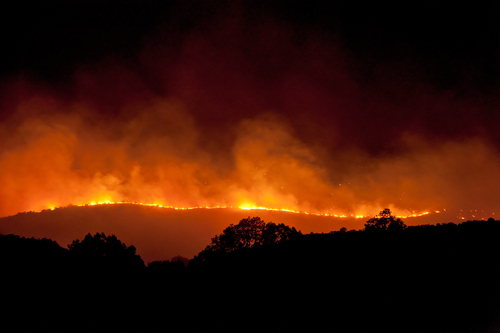According to Matthew Eby, executive director of the nonprofit First Street Foundation, the model is the first attempt to make property-level wildfire-risk scores freely available for homes throughout the contiguous United States.
In recent years, wildfires have caused tens of billions of dollars in damage, and many scientists predict that they will become more frequent and intense in the future, fueled by climate change and other factors.
Using the First Street Foundation's fire-risk scores, real-estate listings site Realtor.com calculated that one in every five single-family homes in the United States faces a wildfire in the next 30 years, representing $8.8 trillion in property value.
The First Street Foundation previously published U.S. flood maps in 2020, stating that millions of homeowners face a significant risk of flooding that is not disclosed by federal flood maps.
According to the First Street Foundation's analysis, 1.5 million properties in the United States, including homes, apartments, hospitals, airports, and government buildings, have extreme wildfire risk, which means they have a 26 percent chance of being involved in a wildfire in the next 30 years.
According to the study, another 2.7 million properties face severe risk, or a 14 percent -to-26 percent chance of being involved in a wildfire in the next 30 years; 6 million face major risk, or a 6 percent -to-14 percent chance; 20.2 million face moderate risk, or a 1 percent -to-6 percent chance; and 49.4 million face minor risk, or a probability of less than 1%.
First Street Foundation began with publicly available data from federal, state, and local government sources to develop its wildfire model. According to Ed Kearns, the organization's chief data officer, it ran simulations of wildfire behavior millions of times to predict whether properties are likely to be in a wildfire and used satellite imagery and other data to estimate the intensity of the potential exposure.
The analysis indicates that the Western United States has the highest number of properties with major wildfire risk or higher, but properties in the majority of states have some exposure to wildfire risk.
The First Street Foundation, comprised of researchers, modelers, and scientists, works to educate homeowners about natural disasters and climate change. It is funded by grants and sells flood-risk data to businesses.
Realtor.com announced that it would incorporate wildfire risk data from the First Street Foundation into its home listings. According to Sara Brinton, lead product manager for Realtor.com, the site already incorporates First Street Foundation's flood-risk data, which has become a popular feature for home shoppers. Realtor.com is owned by News Corp, which also owns The Wall Street Journal.
Estimating property-level wildfire risk is difficult because it varies depending on how well a property is maintained, according to Bob Roper, policy adviser for the Western Fire Chiefs Association who was not involved in the First Street Foundation analysis.
A pile of firewood, for example, next to a house would increase its wildfire risk, he said. "That firewood pile can change in size and scope throughout the year," he explained. "To validate your facts and data, you should do a risk map at least several times a year."
According to Matthew Kahn, a professor of economics at the University of Southern California who has used First Street Foundation's flood data in his research, providing more information about wildfire risks to home buyers can help them make good investments and may affect the value of properties in risky areas.
The states with the most properties that have at least a 0.03 percent chance of being in a wildfire, according to First Street Foundation, are California, Texas, Florida, Arizona, and Oklahoma. New Mexico has the highest proportion of properties with that level of current risk, with 68.6 percent, followed by Wyoming (66.8 percent) and Arizona (58.7 percent).













